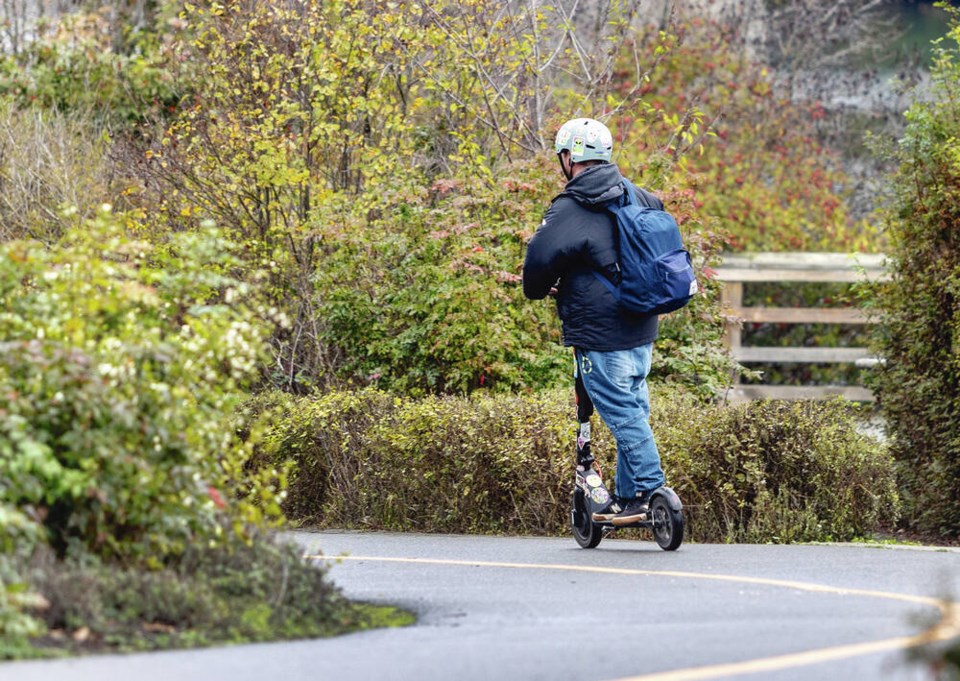As electric skateboards, electric scooters and other micromobility devices become more popular on city streets and in bike lanes, local governments are looking to the province to regulate their use.
The province is running a pilot project on electric kick scooters in several cities to explore their potential.
It says electric kick scooters and other micromobility devices are clean and efficient ways to get around, but they’re not currently allowed on public roads or sidewalks, except in cities participating in the pilot project that have also enacted bylaws to allow for their use.
In pilot communities, such as Vancouver, Coquitlam and Kelowna, the devices must not be ridden on the sidewalk unless local bylaws allow or on roads with a speed limit over 50 kilometres per hour.
The electric scooters should be ridden in bike lanes, or as near as possible to the right side of the street on roads without cycling infrastructure, and only by people 16 or older, the province’s rules dictate.
Nanaimo signed up to participate in the pilot project but stopped short of making bylaw changes due to limited resources, said Jamie Rose, Nanaimo’s manager of transportation.
The province is hoping to learn what changes are needed to accommodate electric kick scooters and similar devices in provincial regulations and to ensure the safety of everyone on roads and sidewalks.
Pilot communities are required to complete annual evaluation reports. Initial reports for the program show e-scooters are popular, promote active transportation, have low injury rates and result in few complaints and infractions, the Ministry of Transportation and Infrastructure said in a statement.
The pilot project is scheduled to end next April.
The City of Victoria sees value in the devices to support climate action and help reduce household costs, said Sarah Webb, manager of transportation, planning and development.
“We also know that there’s an increased demand for mobility options for people and to support that idea of car-light or car-free households. And so when people are using car sharing, or they’re trying out transit, or maybe they’re trying to think about how do they not purchase a second vehicle, micromobility is a great solution for that,” Webb said.
Victoria is leading the way in the region when it comes to trips by active transportation, and micromobility devices could become a larger share of active trips in the future, Webb said.
The city is waiting to hear the results of the current pilot project and what regulatory changes it might bring, Webb said.
At the municipal level, the city will need to consider where people can park micromobility devices. That could include looking at changes to the requirements of new developments to adapt bike parking to add different options for a variety of mobility devices, Webb said.
The Capital Regional District has identified the development of a micromobility policy as a future goal for its regional trails, said Devon Smith, communications coordinator for CRD Regional Parks and Trails.
The CRD currently allows electric bikes on regional trails such as the Galloping Goose, Lochside and E&N Rail Trail, and, like Victoria, is waiting for the province’s pilot project results to determine what else could be allowed on trails, Smith said.
Ray Straatsma, a lecturer in the University of Victoria’s geography department, said the new devices can pose challenges in bike lanes because they can travel faster than the typical cyclist on a pedal bike.
As cycling and other active transportation options become more popular, the bike lanes are increasingly busy, leading to potential conflicts when some vehicles are much faster, he said.
Trips by bike and micromobility devices accounted for eight per cent of daily trips by Greater Victoria residents in 2022, up from five per cent in 2017, according to the Capital Regional District’s latest household travel survey.
If the uptake of micromobility devices continues to grow alongside an increasing number of cyclists, Straatsma said Victoria bike lanes could become so busy that the city might need to consider turning two-way protected lanes into one-way bike lanes to accommodate everyone.
>>> To comment on this article, write a letter to the editor: [email protected]



